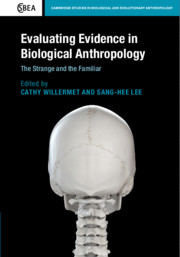Book contents
- Evaluating Evidence in Biological Anthropology
- Cambridge Studies in Biological and Evolutionary Anthropology
- Evaluating Evidence in Biological Anthropology
- Copyright page
- Contents
- Contributors
- Introduction
- Part I The Strange and the Familiar
- Part II (Re)Discovery of Evidence
- 6 (Re)Discovering Paleopathology
- 7 Parsing the Paradox
- 8 Seeing RED
- 9 Paleoanthropology and Analytical Bias
- 10 (Re)Discovering Ancient Hominin Environments
- 11 Discussion and Conclusion
- Index
- References
7 - Parsing the Paradox
Examining Heterogeneous Frailty in Bioarchaeological Assemblages
from Part II - (Re)Discovery of Evidence
Published online by Cambridge University Press: 01 November 2019
- Evaluating Evidence in Biological Anthropology
- Cambridge Studies in Biological and Evolutionary Anthropology
- Evaluating Evidence in Biological Anthropology
- Copyright page
- Contents
- Contributors
- Introduction
- Part I The Strange and the Familiar
- Part II (Re)Discovery of Evidence
- 6 (Re)Discovering Paleopathology
- 7 Parsing the Paradox
- 8 Seeing RED
- 9 Paleoanthropology and Analytical Bias
- 10 (Re)Discovering Ancient Hominin Environments
- 11 Discussion and Conclusion
- Index
- References
Summary
It has been over 25 years since Wood and colleagues published their seminal paper describing the Osteological Paradox (Wood et al. 1992). The Osteological Paradox encompasses a set of phenomena that impede straightforward interpretations of demography and, particularly, health in past populations using data derived from human skeletal assemblages. Wood and colleagues’ seemingly daunting critiques of paleopathology and paleoepidemiology (as conventionally practiced) have not been universally accepted (see, for example: Cohen 1994; Goodman 1993). However, for many scholars in the field, recognition of the Osteological Paradox has inspired a search for creative approaches to skeletal data collection, analysis, and interpretation that will enable us to avoid making unjustified or incorrect inferences from the imperfect data available to us. Many researchers who wish to directly address the issues associated with the Osteological Paradox have been stymied by a lack of clarity or consensus regarding how to do so. This chapter briefly summarizes the Osteological Paradox and presents one possible way to engage with it, while simultaneously addressing socioeconomic differentials in morbidity, a topic of broad interest to anthropologists, human biologists, economists, and public health practitioners.
- Type
- Chapter
- Information
- Evaluating Evidence in Biological AnthropologyThe Strange and the Familiar, pp. 126 - 145Publisher: Cambridge University PressPrint publication year: 2019



